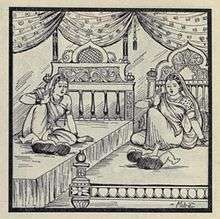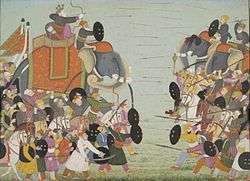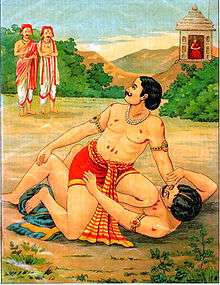Jarasandha
| Jarasandha | |
|---|---|
 Painting showing Bhima slaying Jarasandha | |
| Brihadratha King | |
| Predecessor | Brihadratha |
| Successor | Sahadeva |
| Issue | Sahadeva |
| Dynasty | Brihadratha |
| Father | Brihadratha |
As per the Hindu epic Mahabharata, Jarasandha (Sanskrit: जरासन्ध) was the king of Magadha. He was a descendant of the king Brihadratha, the founder of the Barhadratha dynasty of Magadha. He was also a great devotee of the Hindu god Shiva. He was a great senapati and a Maharathi, but he is generally held in negative light owing to his enmity with the Yadava clan in the Mahabharata.
Etymology
The word Jarasandha is a combination of two Sanskrit words, Jara (जरा) and sandha (सन्ध), "joining". Jara was a demoness who put the two halves of Jarasandha together after finding them by a tree. In return for saving Brihadratha's son, he named Jarasandha after her, and the word sandha, which means "joining". So the meaning of Jarasandha is 'the one who is joined by Jara'.[1]
Legend about his birth


Brihadratha was the king of Magadha. His ancestor Uparichara Vasu had taken over the Chedi Kingdom, and Brihadratha had taken over Magadha. His wives were the twin princesses of Varanasi. While he led a contented life and was a famed king, he was unable to have children for a very long time. Frustrated over his inability to have children, he retreated to the forest and eventually ended up serving a sage named Chandakaushika. The sage took pity on him and on finding the actual cause for his sorrow, gave him a fruit and told him to give it to his wife who in turn will soon become pregnant. But the sage did not know that he had two wives. Not wishing to displease either wife, Brihadratha cut the fruit in half and gave it to both of them. Soon both the wives became pregnant and gave birth to two halves of a human body. These two lifeless halves were very horrifying to view. So, Brihadratha ordered these to be thrown in the forest. A Rakshasi (demoness) named Jara (or Barmata) found these two pieces and held each of these in her two palms. Incidentally when she brought both of her palms together, the two pieces joined together giving rise to a living child. The child cried loudly which created panic for Jara. Not having the heart to eat a living child, the demoness gave it to the king and explained him all that happened. The father was overjoyed to see him.[2]
Chandakaushika arrived at the court and saved the child. He prophesied to Brihadratha that his son will be specially gifted and would be a great devotee of the god Shiva.[3]
Life

Jarasandha became a famed and powerful king, extending his empire far and wide. He prevailed over many kings, and was crowned emperor in Magadha. Many powerful kings, like Narakasura, Pundru Vasudev, Shishupala of Chedi, Shalva of Shuva and Vishmak became his allies. Even while Jarasandha's power continued to grow, he had concerns over his future & that of the empires, as he had no heirs. Therefore, on the advice of his close friend king Banasura, Jarasandh decided to get his two daughters Asti and Prapti married to the heir apparent of Mathura, Kansa. Jarasandha had also lent his army and his personal advise to Kamsa to create a coup d'état in Mathura.
When Jarasandha's two daughters were old enough to be married, he let Kamsa marry them so that an alliance would be formed with the two leaders and so Jarasandha would have an heir. However Kamsa was a bad and cruel leader. Krishna the nephew of Kamsa had been observing the horrors that Kamsa was committing and become very upset. Krishna was so upset that he killed Kamsa. When Krishna killed Kamsa in Mathura, Jarasandha become enraged because Krishna had widowed his two daughters. Jarasandha vowed to get revenge for his two widowed daughters. So Jarasandha attacked Mathura and the Yadavas 17 times. But each and every time Jarasandha was defeated mainly due to Krishna's mastery over archery and also by Balarama's unequalled fighting prowess with mace. At that time in Aryavartha (North India) Krishna was considered as the foremost archer. Later Jarasandha resorted to a cunning strategem. He provoked Kalayavana, a Mlechcha (barbarian) king to attack Krishna. In the long lasting war that ensued Yadavas along with Krishna & Balarama slew entire army of mlechchas including Kalayavana. As victorious yadavas were returning to their homeland suddenly Jarasandha's army attacked Yadavas. Yadavas who were already exhausted due to war with barbarians could not withstand this treacherous attack. This made Krishna and Balarama flee to Dwaraka along with remaining soldiers. Dwaraka was an island and it was not possible for Jarasandha to attack Yadavas afterwards.[2]
Jarasandha has also participated in the Swayamvara of Draupadi, and after being unable to lift the bow, left the place.[4]
In another incident when Jarasandha attacked Duryodhana for abducting the Kashi Princess Bhanumati, Karna comes to the rescue. Karna and Jarasandha fought continuously and Karna defeated Jarasandha. Jarasandha gifted Malini town to Karna as a prize for his skills.
Death

Following the war with Yadavas, Jarasandha planned to conduct a Yagna to please the god Shiva. For this Yagna, He had imprisoned 95 kings and was in need of 5 more kings, after which he was planning to perform the Yagna, sacrificing all the 100 kings. Jarasandha thought that this Yagna will make him an all-powerful emperor in the whole Arya Vartha.
Krishna, on the other hand, made a plan for eliminating Jarasandha. The Pandava king Yudhishthira was planning to make a Rajasuya yagna in order to become the emperor. Krishna convinced his cousin Yudhishthira that Jarasandha was the only obstacle to oppose Yudhishthira from becoming an emperor. Krishna planned a clever scheme to eliminate Jarasandha by making Yudhishthira's brother Bhima wrestle with the Jarasandha in a duel.
Like Karna, Jarasandha was also very good in giving charity donations. After performing his Shiva pooja, he used to give whatever the Brahmins asked for. On one such occasion Krishna, Yudhishthira's brothers Arjuna and Bhima in the guise of Brahmins met Jarasandha. Krishna asked Jarasandha to choose any one of them for a wrestling match. Jarasandha chose Bhima, the strongman, to wrestle. Both of them fought for 14 days. Bhima lost hope to win the battle and sought help of Krishna. Krishna, who then knew of the secret of Jarasandha's weakness took a twig and split it into two. Bhima understood the clue and split Jarasandha's body into two, slaying the king.[5]
After his death, the Pandavas released all the 95 kings imprisoned by Jarasandha and crowned his son, Sahadeva as the king of Magadha. Thus, these 95 kings along with Sahadeva, the new ruler of Magadha became an ally of Pandavas who took part in the Mahabharata war later.
Jainism
Jainism is another ancient religion from India. The essence of Jainism is concern for the welfare of every being in the universe.[6] According to Jain literature, Jarasandha was the ninth and last Prati-Vasudeva (Prati-Narayana) of the current half time cycle (Avasarpini) in Jain cosmology and was slayed (killed) by Krishna who was the ninth and last Vasudeva (Narayana). The mention of this story comes in Acharya Jinasena's Harivamsa Purana. Jarasandha attacked Krishna with his most powerful weapon, Sudarshana Chakra. Sudarshan Chakra instead of killing Krishna, accepted Krishna as its owner and killed Jarasandha. In Jainism, Mahabharata was the fight between Krishna and Jarasandha as opposed to the Hindu version of the epic and Kauravas and Pandavas were mere generals.[7]
Notes
- ↑ "Jarasandha was a very powerful king of Magadha, and the history of his birth and activities is also very interesting - Vaniquotes". vaniquotes.org. Retrieved 2015-12-31.
- 1 2 Chandrakant, Kamala (1977). Krishna and Jarasandha. India Book House Ltd. pp. 3–5. ISBN 81-7508-080-9.
- ↑ "Slaying of Jarasandha - Indian Mythology". www.apamnapat.com. Retrieved 2016-01-10.
- ↑ Squarcini, Frederico (2011). Boundaries, Dynamics, and Constructions of Traditions in South Asia. 244 Madison Ave, #116, New York,NY: Anthem Press. p. 117. ISBN 9780857284303.
- ↑ "The Mahabharata, Book 12: Santi Parva: Rajadharmanusasana Parva: Section V", sacred-texts.com
- ↑ "BBC - Religions - Jainism: Jainism at a glance". Retrieved 2016-01-10.
- ↑ "Download Limit Exceeded". citeseerx.ist.psu.edu. Retrieved 2015-12-31.
References
- Doniger, Wendy (1993), Purana Perennis: Reciprocity and Transformation in Hindu and Jaina Texts, SUNY Press, ISBN 0-7914-1381-0
- Gibbs,Laura. Ph.D. Jarasandha Modern Languages MLLL-4993. Indian Epics.
- Dowson, John (1820–1881). A classical dictionary of Hindu mythology and religion, geography, history, and literature. London: Trübner, 1879 [Reprint, London: Routledge, 1979]. ISBN 0-415-24521-4
- Original Mahabharata by Shri Ved Vyasa
- Gita press,Gorakhpur edition of Mahābhārata
- Ramanand Sagar's "SHRI KRISHNA" serial
- MRITYUNJAY-the story of Karna.

